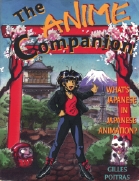 |
Anime Companion Supplement - W
Wa - We - Wi - Wo
This series of pages is a supplement to two of my books The Anime
Companion and The Anime Companion 2�.
For easy browsing go to the: Topical / Subject Index
See the regular entry pages for cross references between variant terms, differing spellings, English to Japanese terms and names:
# - A - B - C - D - E - F - G - H - I - J - K - L - M - N - O - P - Q - R - S - T - U - V - W - Y - Z - Side Bars Special Supplement: Rurouni Kenshin OVAs
- Each Supplement page consists of:
-
1. A list of entries in the books with page numbers.
2. New entries for items not found in the books.
3. Japanese characters for entries
4. Secondary sources used to find information for each entry.
5. Additional information for some entries.
6. Links to select Internet resources related to the entries.
You can also search my entire site:
|
 |
For more information about this supplement see The Anime Companion Supplement main page. Additions are announced in the Anime Companion Supplement News page and in my Blog.
Hyphenated Japanese terms are listed as single words.
The inclusion of an anime or manga title in these entries is not a recommendation of that title, see my Recommended Anime and Manga page for a list of my recommendations
WA SEIRŌ see: seirō (The Anime Companion 2 p.81)
- wagashi (traditional confections) 和菓子
-
Japanese confections, cookies, cakes and candy, sometimes simply called kashi. The term covers a variety of items, mainly sweet, originally intended to be served with tea (cha; The Anime Companion [vol.1] p.16) or as part of the tea ceremony (cha-no-yu; The Anime Companion [vol.1] p.17). Some of the oldest imported styles are from the Nara Period when Chinese confections were introduced by returning scholars. During the Kamakura Period (The Anime Companion [vol.1] p.59) wagashi spread with the expansion of Zen Buddhism (The Anime Companion 2 p.122) and later namban-gashi such as cake were introduced by Europeans in the 16th century. Wagashi are classed into three broad types namagashi (moist), han namagashi (semi-moist) and higashi (dry). Over time a very large variety of wagashi developed often in specific localities using local products. The shapes and colors of many wagashi change according to the seasons so one can find several that are made with identical ingredients but varied in style with the time of year. Two good books in English on wagashi are An Almanac of Urasenke Seasonal Tea Sweets by Sen Tomiko and Wagashi: The Graphics of Japanese Confection by Takaoka Kazuya, Takahashi Mutshuo and Yoda Hiroshi. The strong connection with seasons and the tea ceremony can be seen in that each chapter, organized by month, in Chado: The Way of Tea by Sasaki Sanmi has a section on the kashi for that month.
Anime:
In episode seven of Peacemaker we see a variety of wagashi in a kashiya (traditional confectionary).
Manga:
In Kaze Hikaru (v.3 p.189) several types of wagashi are visible.
Sources:
Hosking, Richard. A Dictionary of Japanese Food p.168
Japan: An Illustrated Encyclopedia p.220
Web Sites:
Japan Wagashi Association
�
WAITING ROOM see: machiai shitsu (meeting room)
- wakadoshiyori (junior councilors, young elders) 若年寄
-
Literally "young elders". This was an office in the bakufu (The Anime Companion 2 p.8) government during the Edo Period (The Anime Companion [vol.1] p.25) they were second in rank to the rōjū. The wakadoshiyori were chosen from the fudai daimyō (The Anime Companion 2 p.20) and usually numbered from three to five and served one at a time in monthly turns. Their duties included supervising the hatamoto (The Anime Companion 2 p.27) and gokenin with the aid of reports from the metsuke. They also dealt with most of the shōgun's guards (bankata), artisans, construction, and physicians. They were expected to lead the hatamoto if war were to break out. The wakadoshiyori were also referred to as shōrō, sansei or rokunin-shū "six person group" as when the position was informally created in 1633 by Tokugawa Iemitsu (The Anime Companion 2 p.102) there were six members. The position would be officially established in 1662 based on Iemitsu's earlier model by Sakai Tadakiyo. The term is variously translated as junior councilors, young elders, assistant councilors and junior elders.
Manga:
In volume 18 of Blade of the Immortal (ch. "Barefoot part 3") Habaki mentions that some of the wakadoshiyori are sympathetic to his experiments and will turn a blind eye to them.
In Lone Wolf and Cub (v.5 p.168) Yamada Asaemon is summoned by the wakadoshiyori Kanō Tōtōmi-no-kami and Mizuno Bungo-no-kami. Later (v.6 p.184) Ōgami Itto is asked to help foil a plot involving a wakadoshiyori.
Sources:
Deal, William E. Handbook to Life in Medieval and Early Modern Japan p.97, 100
Goedertier, Joseph M. A Dictionary of Japanese History p.305
Japan: An Illustrated Encyclopedia p.1681
Totman, Conrad. Politics in the Tokugawa Bakufu 1600-1843 p.207, 211, 303n27
�
- wakame わかめ or 若布 or 和布 (The Anime Companion 2 p.112)
- Sources:
Ashburne, John & Abe Yoshi World Food Japan p.75, 150
Eating in Japan p. 150
Hosking, Richard. A Dictionary of Japanese Food p.169
- wakame zake (seaweed sake) わかめ酒
-
Sake, or other alcoholic beverages such as wine, cupped in a woman's pubic area when she has her thighs tightly closed. There is a routine used in strip clubs where an audience member is chosen and invited to have a drink from the crotch of a woman on stage. The wakame (The Anime Companion 2 p.112) part of the name come from the curliness of pubic hair.
Manga:
In Maka-Maka (v.1 p.24) Jun says "It's seaweed sake" when Nene makes a puddle of water at her crotch as they goof around in the bath.
Sources:
Sinclair, Joan. Pink Box: Inside Japan’s Sex Clubs p.189
�
WAKASHUDŌ see: shudō (the way of loving boys)
- Wakō Clock Tower 和光の時計台 or 和光の時計塔 (The Anime Companion 2 p.112)
- Source:
A Look Into Tokyo p.125
WAKU HINOMI see: hinomi (fire lookout towers)
WALL (INTERIOR) AND SCREEN PAINTING see: shōheiga (The Anime Companion 2 p.87)
WALL BAKEMONO see nurikabe (wall bakemono)
WALL MOUNTED HOT WATER HEATER see: yuwakashiki (The Anime Companion 2 p.120)
WANGAN EXPRESSWAY see: shuto kōsoku wangan sen (The Anime Companion 2 p.90)
- wankosoba わんこそば or 椀子蕎麦
-
A way of serving cold soba (The Anime Companion 2 p.90) that originated in Iwate Ken (The Anime Companion 2 p.33). In this method the soba is served in very small bowls, each holding a mouthful of soba. As the customer eats fresh bowls are placed on the table as fast as the earlier one was emptied. When one is full they simply cover their dish as a signal for the waitress to stop. Accompanying the soba are garnishes usually six of seven kinds and dipping broth. Each year the All-Japan Wanko-Soba Eating Contest is held at Hanamaki-shi in Iwate Ken.
Anime:
Ran suddenly pops up saying "wanko buckwheat noodles" in Super Gals! (ep 4)
Sources:
Ashburne, John & Abe Yoshi. World Food Japan p.129
Hosking, Richard. A Dictionary of Japanese Food p.169
Illustrated Eating in Japan p.110
�
WAR LITERATURE see: sensō bungaku (The Anime Companion 2 p.82)
- warabi (bracken) わらび or 蕨 (The Anime Companion 2 p.113)
- Sources:
Eating in Japan p.83, 100
Hosking, Richard. A Dictionary of Japanese Food p.169
WARAJI see: zōri (The Anime Companion [vol.1] p.151)
- wara ningyō (straw doll) 藁人形 (The Anime Companion 2 p.112)
- Sources:
Baten, Lea Identifying Japanese Dolls p.95 & 123
- waribiki tiketto (discount ticket) 割引チケット
-
Discount tickets or coupons given out by a variety of businesses. These days they are not only given away by hand and in magazines. They are also given out at information centers and on websites. Even the fūzoku (sex industry) uses these to bring in new customers.
Anime:
Moko gives discount ticket to Funaki in My Fair Masseuse (ep.2) which results in him becoming a regular customer at the soapland (see: sōpurando, The Anime Companion [vol.1] p.125) where she works. You can see the kanji (The Anime Companion [vol.1] p.61) and kana (The Anime Companion [vol.1] p.60) on the tickets for "waribiki ticket" as he holds them.
Manga:
On the title page for chapter 19 of GTO The Early Years (v.2 p. 25) Abe grins and holds three soapland tickets.
Sources:
Sinclair, Joan. Pink Box: Inside Japan's Sex Clubs p.189
�
WARNING STAFF see: keisaku (The Anime Companion 2 p.44)
WARRING STATES PERIOD see: Sengoku jidai (The Anime Companion [vol.1] p.113
WARRIOR see: bushi (The Anime Companion 2 p.43)
WARRIOR PILGRIMAGE or JOURNEY see: musha shugyō (The Anime Companion 2 p.58)
- wasabi わさび or 山葵 (The Anime Companion 2 p.113)
- Sources:
Eating in Japan p.94, 113, 160
Hosking, Richard. A Dictionary of Japanese Food p.82, 170, 233
Vardaman, James M. and Michiko Sakaki Vardaman. Japan From A to Z p.122
- Waseda Daigaku (Waseda University) 早稲田大学 OLD FORM 早稻田大學 (The Anime Companion [vol.1] p.144)
- Sources:
A Look Into Tokyo p.160
Japan: An Illustrated Encyclopedia p.1688
Who's Who of Japan p.156
Web Site:
The Waseda University Web site:
The top page in Japanese
The English top page
WASEDA UNIVERSITY see: Waseda Daigaku (The Anime Companion [vol.1] p.144)
WASHCLOTH see: oshibori (small damp towel)
WATCHER see: metsuke (inspector, censor)
WET WASHCLOTH see: oshibori (small damp towel)
- water holding as punishment (The Anime Companion [vol.1] p.145)
- Sources:
Who's Who of Japan p.163
WATER LILY see: suiren (water lily)
WATER MARGIN see: Suikoden (The Anime Companion 2 p.92)
WATER, POURING OVER SHOULDER see: mizugori (The Anime Companion [vol.1] p.86)
WATER SPRITE see: kappa (The Anime Companion [vol.1] p.61)
WATER, STANDING UNDER A WATERFALL see: mizugori (The Anime Companion [vol.1] p.86)
WATER TRADE see: mizushōbai
WATER, USED IN PURIFICATION see: misogi , mizugori (The Anime Companion [vol.1] p.86)
WATERMELON see: suika (The Anime Companion 2 p.92)
WATERMELON SMASHING WITH A STICK see: suika-wari (The Anime Companion [vol.1] p.126)
WAVING see: Gestures (sidebar) (The Anime Companion [vol.1] p. 148)
WAY OF LOVING BOYS see: shudō (the way of loving boys)
WAY OF TEA see: cha-no-yu (The Anime Companion [vol.1] p.17)
WAY OF THE FIST see: kempō (The Anime Companion 2 p.44)
WAY OF THE WARRIOR see: bushidō (The Anime Companion 2 p.11)
WAY OF YIN AND YANG see: Ommyōdō
WEAPON, DECEPTIVE see: shikomibuki (deceptive weapon)
WEAPON, HIDDEN see: kakushibuki (hidden weapon)
WEAPONS see: WEAPONRY/WAR - WEAPON in the subject index.
WEARING HEADBAND WITH CANDLES see: ushi no toki mairi (The Anime Companion 2 p.111)
WEARING SURGICAL MASKS ON THE STREET see: Surgical Masks Worn In Public (The Anime Companion [vol.1] p.127)
WEARING SWORDS FORBIDDEN BY LAW see: Haitōrei (The Anime Companion 2 p.25)
WEASEL SLASH see: kamaitachi (weasel slash)
WEATHER PREDICTING BY KICKING A GETA see: geta-uranai
WEDDING CEREMONY see: shinzen kekkon (The Anime Companion [vol.1] p.121)
WHEEL GRINDER FOR MEDICATION see: yagen
WELCOMING FIRE see: mukaebi (welcoming fire)
WELSH ONION see: negi (The Anime Companion 2 p.61)
WESTERN PURE LAND see: Gokuraku (The Anime Companion 2 p.24)
WHITE COLLAR WORKER see sarariman ("salaried man") (The Anime Companion [vol.1] p.111)
WHITE COSTUME FOR RELIGIOUS CEREMONIES see: saifuku (The Anime Companion [vol.1] p.107)
- White Day ホワイトデー or ホワイトデイ (The Anime Companion [vol.1] p.145)
- Sources:
Vardaman, James M. and Michiko Sakaki Vardaman Japan From A to Z p.124
WHITE LILY OF THE VALLEY see: tanima no shirayuri (white lily of the valley)
WHITE ROBE FOR CORPSE see: katabira (unlined kimono)
WHITE SQUARE MASK see: zōmen (The Anime Companion 2 p.123)
WHITE TIGER BRIGADE see: Byakkotai (The Anime Companion 2 p.11)
WHITE TRIANGLE ON CORPSE OR GHOST HEAD see: hitaikakushi (triangle on forehead)
WHITING see: kisu (fish)
WILD BOAR see: inoshishi (The Anime Companion 2 p.32)
WILD GREENS see: sansai (The Anime Companion 2 p.78)
WILDCAT see: Iriomote yamaneko (Iriomote wildcat)
WILLOW see: yanagi (The Anime Companion [vol.1] p.146)
WIND BELLS see: fūrin (The Anime Companion [vol.1] p.30)
WIND, FOREST, FIRE, MOUNTAIN see: fū-rin-ka-zan (The Anime Companion [vol.1] p.31)
WIND INSTRUMENT WI SEVERAL PIPES see: shō (mouth organ)
WIND KAMI see Fujin (wind kami)
WINTER SOLSTICE see tōji (winter solstice)
WOLVES OF MIBU see: Shinsengumi (The Anime Companion 2 p.86)
WOMAN DECEIVER see: onnatarashi (The Anime Companion 2 p.69)
WOMAN WITH TWO MOUTHS see: futakuchi-onna (two mouthed woman)
WOMAN, YOUNG see: shōjo (The Anime Companion 2 p.87)
WOMAN'S OVER GARMENT OR ROBE see: uchikake (woman's over garment)
WOO OR BAMBOO FOOD STEAMER see: seirō (The Anime Companion 2 p.81)
WOODBLOCK PRINTS see: ukiyo-e (Pictures of the Floating World)
WOODEN BOARDS & BAMBOO CLACKERS see: naruko
WOODEN CHEST see: tansu (The Anime Companion 2 p.97)
WOODEN PADDLE FOR GAME see: hagoita (The Anime Companion [vol.1] p.38)
WOODEN PLAQUES, HANGING see: ema (The Anime Companion [vol.1] p.26)
WOODEN SHOES see: geta (The Anime Companion [vol.1] p.34)
WOODEN STAKES IN GRAVEYARD see: sotoba (The Anime Companion [vol.1] p.125)
WORCESTER SAUCE see: sōsu (vegetable sauce)
WORD TABOOS AND EXPRESSIONS see: imikotoba (taboo words and expressions)
WORK AWAY FROM FAMILY see: tanshin funin (absent father)
WRAP AROUND UNDERGARMENT see: koshimaki (hip wrapping)
WRAPPING CLOTH see: furoshiki (The Anime Companion [vol.1] p.31)
WRITTEN HISTORY OF JAPAN see: Nihon Shoki (Chronicle of Japan)
- WRITING see:
-
kana (The Anime Companion [vol.1] p.60)
kanji (The Anime Companion [vol.1] p.61)
For easy browsing go to the: Topical / Subject Index
# - A - B - C - D - E - F - G - H - I - J - K - L - M - N - O - P - Q - R - S - T - U - V - W - Y - Z - Side Bars
Special Supplement: Rurouni Kenshin OVAs
You can also search my entire site:



